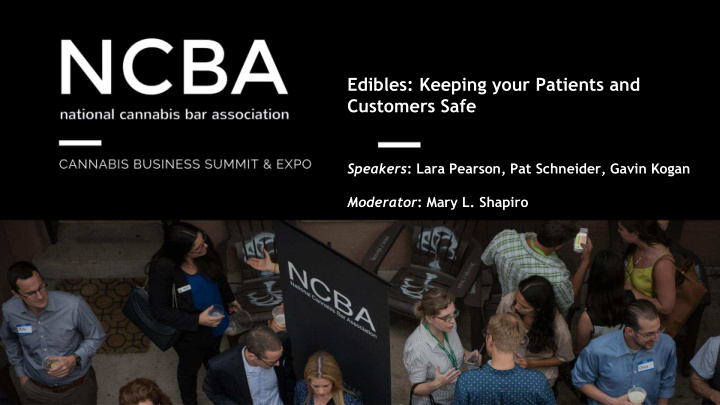



Edibles: Keeping your Patients and Customers Safe Speakers : Lara Pearson, Pat Schneider, Gavin Kogan Moderator : Mary L. Shapiro
Speakers Lara Pearson, BrandGeek, Pat Schneider, Healthy Bizz Gavin Kogan, Attorney Founder lara@brandgeek.net pat@healthybizz.com gavinkogan@gmail.com
Safety First: Know About Your state’s laws, regulations, and rules 1. 2. The FDA 3. Product Recall 4. Product Liability 5. Trademarks 6. Privacy 7. False/Misleading Advertising
Pat Schneider Pat Schneider is a General Management “C - suite” executive with solid P&L experience and expertise in turnarounds. She has a strong consumer products background in leading existing business units, opening new markets and launching products globally for organizations including: P&G, J&J, Bristol-Myers Squibb, Bayer, Herbalife, Metagenics, Twinlab and Nelson Bach. She is currently CEO of Healthy Bizz, a strategic consultancy providing guidance to start-ups in the areas of business strategy, marketing, new product development, regulatory and operations for clients in the natural food, nutritional and legal cannabis related market sectors. Pat is also an advisor to members of Canopy Boulder/San Francisco, a mentorship-driven seed-stage business accelerator for entrepreneurs in the legal marijuana industry. Pat holds a BS in Microbiology, MBA in Finance & Marketing, JD in Commercial Law and is a licensed attorney in California. Pat can be reached at Pat@HealthyBizz.com or 310-779-6695
Overview • Under Federal Law, cannabis is an “unapproved” ingredient being added to current food products – puts infused edibles in an “undefined” area. • “State approved” cannabis industry analogous to mid -1990s Dietary Supplement industry when there was less FDA oversight. • Considerations and decisions made early in the product development process can minimize your risk and help your business “Structure for Success.”
Labeling & Packaging Issues Proper labeling can avoid costly litigation • May 2016: 1st Wrongful Death Lawsuit in Recreational MJ industry • Failure to Warn • Failure to Properly Dose • Failure to Provide Adequate Instructions • Liability throughout stream of commerce • Manufacturer • Retailer
Labeling & Packaging Issues Two issues to consider when labeling and packaging a cannabis infused edible: • Product Category • Jurisdiction
Product Categories When combining an edible food product with an ingredient that is classified as a Schedule 1 drug, which product category does the resulting infused edible belong? • Food • Drug • Dietary Supplement • Category choice determines: • Claims and label restrictions • Packaging requirements • cGMP standards (Manufacturing plant and Warehouse)
Product Categories • Food: • Combining cannabis as an ingredient in an infused edible results in an “adulterated” product subject to FDA seizure • Drug: • Lengthy clinical trials required and, subsequent, approval by the FDA • Dietary Supplement: • Claims and label restrictions but faster route to market
Comparison of Product Categories Food Drug Dietary Supplement Label Claims Allowed Nutrient Content Disease or Condition Structure/Function General Health Nutrient Deficiency Example Contains 100 Calories Relieves Arthritis Pain Supports Healthy Joints Substantiation Not False & Misleading FDA-Approved Double-Blind Placebo Food use pre-1994 Required for Claims Controlled Human Clinical Trials (2) Scientific Evidence Support Not False & Misleading Facts Panel Nutrition Drug Supplement Time to Market 30 days 2-5+ years 30 days (Pre-Mktg) FDA Market Entry GRAS IND & NDA (RX) GRAS or NDI Requirements Monograph & GRASE (OTC) cGMP Standard (P & Food Pharmaceutical Dietary Supplement WH) Packaging Tamper Evident Tamper Evident & CRC Tamper Evident & CRC Requirements* FDA CFR 21 CFR 110 21 CFR 210 & 211 (Rx) 21 CFR 111 21 CFR 330 (OTC)
Facts Panel Examples
Facts Panel Examples – July 2018
MJ Edible: Facts Panel & Dosing Examples
MJ Edible: Serving/Dosing Example
CBD Dietary Supplement Package
CBD Dietary Supplement Package
CBD Food Package
MJ Edible: Packaging Example (CRC/TE)
MJ Edible: Packaging Example (CRC/TE)
cGMPs • Current Good Manufacturing Practices are FDA regulations. • Set of operating procedures to assure proper design, monitoring, and control of manufacturing processes and facilities. • Regulations cover both the manufacturing facility and the warehouse. • Subject to governmental inspections – some are without • Non- compliance results in a warning letter or a “483 Observation” • Time-sensitive response • CAPA System required • Failure to correct could result in product seizure and potential criminal charges • In the absence of Federal oversight, comply with State requirements.
Jurisdictional Issues • Currently cannabis remains illegal at the Federal Level. • In the absence of Federal regulations, know and follow your state’s unique regulations governing: • Packaging • Labeling • Manufacturing • State laws can be more restrictive than (eventual) Federal Law but state laws can not be less restrictive. • Structure for Success: Follow your state law until Federal Law supersedes
Useful Links • FDA CFRs • https://www.accessdata.fda.gov/scripts/cdrh/cfdocs/cfcfr/CFRSearch.cfm?CFRPart=110 • http://www.accessdata.fda.gov/scripts/cdrh/cfdocs/cfcfr/cfrsearch.cfm?cfrpart=111 • State Packaging Guide • https://www.leafly.com/news/industry/a-state-by-state-guide-to-cannabis-packaging-and-labeling-laws • FDA Sites • http://www.fda.gov/Food/IngredientsPackagingLabeling/LabelingNutrition/ucm2006873.htm • http://www.fda.gov/Food/GuidanceRegulation/GuidanceDocumentsRegulatoryInformation/DietarySupplements/ucm070 597.htm#4-1 • http://www.fda.gov/Food/DietarySupplements/ • http://www.fda.gov/Food/GuidanceRegulation/CGMP/ucm079496.htm
Recommend
More recommend